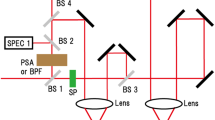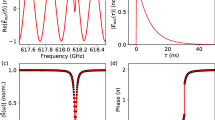Abstract
We demonstrate, with detailed examples, a method to retrieve the phase and group-delay responses of plasmonic metal Bragg gratings (MBGs) from their reflection and transmission spectra. The method is based on the Hilbert transform (HT) that relates the phase and the amplitude spectrum of a minimum-phase system. For the retrieval of the reflection phase, if the propagation loss of the grating is negligible, the method cannot tolerate any asymmetry in the grating profile and thus fails to operate for practical low-loss fiber or dielectric-waveguide Bragg gratings, where the fabrication errors are sufficient to destroy the symmetry requirement. The large propagation loss of the surface plasmon mode, however, makes possible the retrieval of the reflection phase of an MBG that contains a certain degree of asymmetry in the grating profile. For the retrieval of the transmission phase, the symmetry requirement is not an issue, while a large propagation loss can introduce significant errors in the retrieved phase spectrum. It is possible, however, to largely reduce such errors by applying the HT method to the spectrum with the background propagation loss artificially removed. The HT method provides a simple and effective way to obtain the phase and group-delay characteristics of MBGs, which are difficult to measure directly, and can find applications in the development of grating-based plasmonic devices.









Similar content being viewed by others
References
Burke JJ, Stegeman GI, Tamir T (1986) Surface-polariton-like waves guided by thin, lossy metal films. Phys Rev B 33:5186–5201
Barnes WL, Dereux A, Ebbesen TW (2003) Surface plasmon subwavelength optics. Nature 424:824–830
Lakowicz JR (2006) Plasmonics in biology and plasmon-controlled fluorescence. Plasmonics 1:5–33
Charbonneau R, Lahoud N, Mattiussi G, Berini P (2005) Demonstration of integrated optics elements based on long-ranging surface plasmon polaritons. Opt Express 13:977–984
Boltasseva A, Bozhevolnyi SI (2006) Directional couplers using long-range surface plasmon polariton waveguides. IEEE J Sel Top Quantum 12:1233–1241
Nikolajsen T, Leosson K, Bozhevolnyi SI (2005) In-line extinction modulator based on long-range surface plasmon polaritons. Opt Commun 244:455–459
Nikolajsen T, Leosson K, Bozhevolnyi SI (2004) Surface plasmon polariton based modulators and switches operating at telecom wavelengths. Appl Phys Lett 85:5833–5835
Jette-Charbonneau S, Charbonneau R, Lahoud N, Mattiussi GA, Berini P (2005) Demonstration of Bragg gratings based on long ranging surface plasmon polariton waveguides. Opt Express 13:4674–4682
Boltasseva A, Bozhevolnyi SI, Nikolajsen T, Leosson K (2006) Compact Bragg gratings for long-range surface plasmon polaritons. J Light Technol 24:912–918
Marano M, Longhi S, Laporta P, Belmonte M, Agogliati B (2001) All-optical square-pulse generation and multiplication at 1.5 μm by use of a novel class of fiber Bragg gratings. Opt Lett 26:1615–1617
Asghari MH, Azaña J (2009) All-optical Hilbert transformer based on a single phase-shifted fiber Bragg grating: design and analysis. Opt Lett 34:334–336
Li M, Janner D, Yao J, Pruneri V (2009) Arbitrary-order all-fiber temporal differentiator based on a fiber Bragg grating: design and experimental demonstration. Opt Express 17:19798–19807
Eggleton BJ, Ahuja A, Westbrook PS, Rogers JA, Kuo P, Nielsen TN, Mikkelsen B (2000) Integrated tunable fiber gratings for dispersion management in high-bit rate systems. J Light Technol 18:1418–1432
Longhi S (2005) Group delay tuning in active fiber Bragg gratings: from superluminal to subluminal pulse reflection. Phys Rev E 72:056614
Muriel MA, Carballar A (1997) Phase reconstruction from reflectivity in uniform fiber Bragg gratings. Opt Lett 22:93–95
Zou B, Chiang KS (2013) Phase retrieval from transmission spectrum for long-period fiber gratings. J Light Technol 31:2223–2229
Poladian L (1997) Group-delay reconstruction for fiber Bragg gratings in reflection and transmission. Opt Lett 22:1571–1573
Skaar J, Engan HE (1999) Phase reconstruction from reflectivity in fiber Bragg gratings. Opt Lett 24:136–139
Chen C, Berini P, Feng D, Tanev S, Tzolov V (2000) Efficient and accurate numerical analysis of multilayer planar optical waveguides in lossy anisotropic media. Opt Express 7:260–272
Bienstman P, Baets R (2001) Optical modelling of photonic crystals and VCSELs using eigenmode expansion and perfectly matched layers. Opt Quant Electron 33:327–341
Snyder AW, Love JD (1983) Optical waveguide theory. Chapman and Hall, New York
Papoulis A (1962) The Fourier integral and its applications. McGraw-Hill, New York
Ohta K, Ishida H (1988) Comparison among several numerical integration methods for Kramers-Kronig transformation. Appl Spectrosc 42:952–957
Palik E (1985) Handbook of optical constants of solids. Academic, Orlando
Author information
Authors and Affiliations
Corresponding author
Rights and permissions
About this article
Cite this article
Zou, B., Chiang, K.S. Application of the Hilbert Transform Method for the Retrieval of the Phase Characteristics of Plasmonic Metal Bragg Gratings. Plasmonics 10, 107–115 (2015). https://doi.org/10.1007/s11468-014-9783-3
Received:
Accepted:
Published:
Issue Date:
DOI: https://doi.org/10.1007/s11468-014-9783-3




